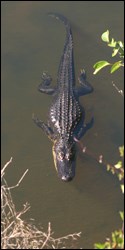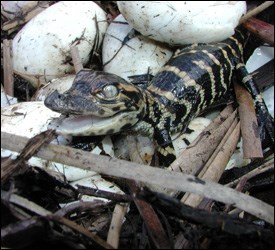
NPS photo The American alligator (Alligator mississippiensis) ranges throughout the southeastern United States, and alligators within Everglades National Park exist at the southern extreme of their range. Alligators primarily inhabit freshwater swamps and marshes and can also be found in rivers, lakes, and smaller bodies of water. They can tolerate a reasonable degree of salinity for short periods of time and are occasionally found in brackish water around mangrove swamps even though they lack the salt-secreting glands present in crocodiles. Dens are burrowed out and used for shelter and aestivation when winter temperatures fall or more commonly in the Everglades, when conditions are very dry. Even outside their dens they can tolerate limited periods of freezing conditions. During the winter dry season they modify their habitat by excavating “alligator holes,” which also provide a refuge for other animals during dry periods. 
NPS photo Adult male alligators occasionally reach 13 to 15 feet in length. Maximum length for females is approximately 10 feet. Both sexes tend to be smaller in South Florida. The snout of an alligator is characteristically broad, although the shape can vary slightly among populations and individuals. The bright yellow cross-bands that juvenile alligators sport against a black background provide effective camouflage. The yellow banding fades away as the juveniles mature. Juveniles eat a wide variety of small invertebrates, particularly insects, as well as small fish and frogs. The adult diet typically consists of fish, turtles, small mammals, birds, and reptiles, including small alligators. Feeding activity is governed by water temperature, and foraging ceases if the temperature drops below 68 to 73 degrees Fahrenheit. The color of adult alligators varies with habitat and can be olive, brown, gray, or nearly black, with a creamy underside. Algae-laden waters produce greener skin, while tannic acid from overhanging trees can produce darker skin. 
NPS / Lori Oberhofer Females reach sexual maturity at approximately 6 feet in length. Springtime courtship rituals are complex and can last for several hours. Female alligators choose nest sites above the water level to reduce the chance of flooding, which would kill most eggs within 12 hours of submergence. Completed nests are about 3.5 feet high and twice as wide. Females remain near the nest during the incubation period, which averages 58 to 63 days. When danger threatens, she will rapidly return to the nest to protect her eggs. The temperature at which the eggs develop determines the sex of the hatchling. Eggs that incubate at temperatures ranging from 90 to 93 degrees Fahrenheit hatch as males, while those that incubate from 82 to 86 degrees hatch as females. Intermediate temperature ranges yield a mix of both male and female hatchlings. The female opens the nest in response to calls from the hatchlings when the eggs are ready to hatch. She carries 8 to 10 hatchlings at a time in her mouth down to the water, pulling her tongue down to make a pouch in which they sit. Upon arrival in the water, she opens her jaws and shakes her head gently from side to side, encouraging the hatchlings to swim out. The juveniles aggregate in pods that may include hatchlings from other nests and remain close to the mother typically as long as one year, but sometimes for two or even three years. This social system affords protection during their most vulnerable life stage from predators such as raccoons, large fish, birds, and even other alligators –mostly large, dominant males. The females respond swiftly to calls from hatchlings facing impending danger. Hatchlings grow rapidly, especially during their first four years, sometimes averaging more than 1 foot of growth for each year of life. 
NPS photo Alligators are an important part of the Everglades ecosystem and are considered a keystone species of the park. The nesting activity of female alligators is important for the creation of peat. Several turtle species, such as the Florida red-bellied turtle (Chrysemys nelsoni), incubate their eggs inside both active and old/abandoned alligator nests. Water remains in alligator holes throughout the year except during severe drought conditions. As the dry season approaches and water dries up from other areas within the Everglades, the retained water causes alligator holes to become a refuge for a variety of wildlife. Although these animals become easy prey for alligators and other predators such as wading birds, the value of the refuge outweighs the risk. Human conflicts with alligators are rare and generally not serious, but incidents do occur and have been reported. Education and awareness is the best long-term way to avoid future incidents. Most alligator attacks on humans are attributed to the illegal feeding of alligators, which makes them bolder, less wary of humans, and more likely to attack instead of flee. It is illegal to feed or provoke alligators as well as all other wildlife. Dwindling populations of alligators were the result of hunting and loss of habitat, and the American alligator was listed as an endangered species in 1967 under a law that preceded the Endangered Species Act of 1973. The number of alligators began to rebound when alligator farms opened and hunting was outlawed, easing the pressure on wild populations. However, even after hunting was prohibited in Florida, illegal poaching continued into the 1970s because the belly skin of alligators produces high-quality leather. Were it not for additional changes in the law controlling the movement of alligator hides, extinction may have been possible. Populations have since improved considerably, and alligators were removed from the list of endangered species in 1987 and are continuing to thrive in Florida today. The requested video is no longer available.
Additional Resources Perhaps no other animal is more closely identified with the Everglades than the American alligator. This keystone species bears considerable importance in the health and function of south Florida's ecology. It is well understood that reproductive success is contingent on many factors, particularly hydrology. This project is the culmination of 13 years of study on the nesting success of alligators in Everglades National Park. As part of this research, nearly 850 nests were surveyed during this time, the majority of which were located in Shark River Slough. This investigation provides valuable insight into hatchling success and nest site selection, as well as impacts from flooding, predation, and infertility.
Reference: American Alligator Nesting and Reproductive Success in Everglades National Park |
Last updated: March 7, 2025
